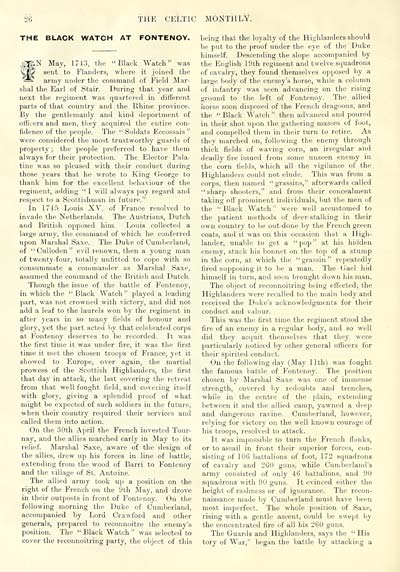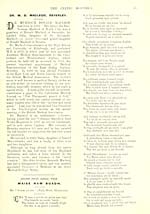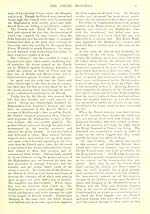Blair Collection > Celtic monthly > Volume 6, 1898
(46)
Download files
Complete book:
Individual page:
Thumbnail gallery: Grid view | List view

THE CELTIC MONTHLY.
THE BLACK WATCH AT FONTENOY.
,i7|.N May, 1743, the "Black Watch" was
vjjy sent to Flanders, where it joined the
=^ army under the coniinand of Field Mar-
shal the Earl of Stair. During that year and
next the regiment was quiirtered in different
parts of that country and the Rhine province.
By the gentlemanly and kind deportment of
otticers and men, they acquired the entire con-
fidence of the people. The " Soldats Eecossais "
were considered the most trustworthy guards of
property ; the people preferred to have them
always for their protection. The Elector Pala-
tine was .so pleased with their conduct during
those years that he wrote to King George to
thank him for the excellent behaviour of the
regiment, adding " I will always pay regard and
res|)ect to a Scottishman in future."
In 1745 Louis XV. of France resolved to
invade the Netherlands. The Ausstrians, Dutch
and British opposed him. Louis collected a
large army, the command of which he conferred
upon Marshal Saxe. The Duke of Cumberland,
of " CuUoden " evil renown, then a young man
of twenty-four, totally unfitted to cope with so
consummate a commander as Marshal Saxe,
assumed the command of the British and Dutch.
Though the issue of the battle of Fontenoy,
in which tiie "Black Watch" played a leading
part, was not crowned with victory, and did not
add a leaf to the laurels won by the regiment in
after years in so many fields of honour and
glory, yet the part acted by that celebrated corps
at Fontenoy deserves to be recorded. It was
the first time it was under fire, it was the first
time it met the chosen troops of France, yet it
showed to Europe, over again, the martial
prowess of the Scottish Highlanders, the first
that day in attack, the last covering the retreat
from that well-fought field, and covering itself
with glory, giving a splendid proof of what
might be expected of such soldiers in the future,
when their country required their services and
called them into action.
On the 30th April the French invested Tour-
nay, and the allies marched early in May to its
relief. Marshal Saxe, aware of the design of
the allies, drew up his forces in line of battle,
extending from the wood of Barri to Fontenoy
and the village of St. Antoine.
The allied army took up a position on the
right of the French on the 9th May, and drove
in their outposts in front of Fontenoy. On the
following morning the Duke of Cumberland,
accompanied by Lord Crawford and other
generals, prepared to reconnoitre the enemy's
position. The " Black Watch " was selected to
cover the reconnoitring party, the object of this
being that the loyalty of the Highlanders should
be put to the proof under the eye of the Duke
himself. Descending the slope accompanied by
the English 19th regiment and twelve squadrons
of cavalry, they found themselves opposed by a
large body of the enemy's horse, while a column
of infantry was seen advancing on the rising
ground to the left of Fontenoy. The allied
horse soon disposed of the French dragoons, and
the "Black Watch" then advanced and poured
in their shot uj)on the gathering masses of foot,
and compelled them in their turn to retire. As
they marched on, following the enemy through
tliick fields of waving corn, an irregular and
deadly fire issued from some unseen enemy in
the corn fields, which all the vigilance of the
Highlanders could not elude. This was from a
corps, then named " grassins," afterwards called
"sharp shooters," and from their concealment
taking ofl" prominent individuals, but the men of
the '• Black Watch " were well accustomed to
the ])atient methods of deer-stalking in their
own country to be out-done by the French green
coats, and it was on this occasion that a High-
lander, unable to get a " pop " at Ins hidden
enemy, stuck his bonnet on the top of a stump
in the corn, at which the "grassin" repeatedly
fired supposing it to be a man. The Gael hid
himself in turn, and .soon brought down his man.
The object of reconnoitring being efi'ected, the
Highlanders were recalled to the main body and
received the Duke's acknowledgments for their
conduct and valour.
This was the first time the regiment .stood the
fire of an enemy in a regular body, and so well
did they acquit themselves that they were
particularly noticed by other general officers for
their spirited conduct.
On the following day (May 11th) was fought
the famous battle of Fontenoy. The position
chosen by Marshal Saxe was one of immense
strength, covered by redoubts and trenches,
while in the centre of the plain, extending
between it and the allied camp, yawned a deep
and dangerous ravine. Cumberland, however,
relying for victory on the well known courage of
his troops, resolved to attack.
It was impossible to turn the French flanks,
or to assail in front their superior forces, con-
sisting of lOG battalions of foot, 172 squadrons
of cavalry and 260 guns, while Cumberland's
army consisted of only 46 battalions, and 90
squadrons with 90 guns. It evinced either the
height of rashness or of ignorance. The recon-
naissance made by Cumberland must have been
most imperfect. The whole position of Saxe,
rising with a gentle ascent, could be swept by
the concentrated fire of all his 260 guns.
The Guards and Highlanders, says the " His
tory of War," began the battle by attacking a
THE BLACK WATCH AT FONTENOY.
,i7|.N May, 1743, the "Black Watch" was
vjjy sent to Flanders, where it joined the
=^ army under the coniinand of Field Mar-
shal the Earl of Stair. During that year and
next the regiment was quiirtered in different
parts of that country and the Rhine province.
By the gentlemanly and kind deportment of
otticers and men, they acquired the entire con-
fidence of the people. The " Soldats Eecossais "
were considered the most trustworthy guards of
property ; the people preferred to have them
always for their protection. The Elector Pala-
tine was .so pleased with their conduct during
those years that he wrote to King George to
thank him for the excellent behaviour of the
regiment, adding " I will always pay regard and
res|)ect to a Scottishman in future."
In 1745 Louis XV. of France resolved to
invade the Netherlands. The Ausstrians, Dutch
and British opposed him. Louis collected a
large army, the command of which he conferred
upon Marshal Saxe. The Duke of Cumberland,
of " CuUoden " evil renown, then a young man
of twenty-four, totally unfitted to cope with so
consummate a commander as Marshal Saxe,
assumed the command of the British and Dutch.
Though the issue of the battle of Fontenoy,
in which tiie "Black Watch" played a leading
part, was not crowned with victory, and did not
add a leaf to the laurels won by the regiment in
after years in so many fields of honour and
glory, yet the part acted by that celebrated corps
at Fontenoy deserves to be recorded. It was
the first time it was under fire, it was the first
time it met the chosen troops of France, yet it
showed to Europe, over again, the martial
prowess of the Scottish Highlanders, the first
that day in attack, the last covering the retreat
from that well-fought field, and covering itself
with glory, giving a splendid proof of what
might be expected of such soldiers in the future,
when their country required their services and
called them into action.
On the 30th April the French invested Tour-
nay, and the allies marched early in May to its
relief. Marshal Saxe, aware of the design of
the allies, drew up his forces in line of battle,
extending from the wood of Barri to Fontenoy
and the village of St. Antoine.
The allied army took up a position on the
right of the French on the 9th May, and drove
in their outposts in front of Fontenoy. On the
following morning the Duke of Cumberland,
accompanied by Lord Crawford and other
generals, prepared to reconnoitre the enemy's
position. The " Black Watch " was selected to
cover the reconnoitring party, the object of this
being that the loyalty of the Highlanders should
be put to the proof under the eye of the Duke
himself. Descending the slope accompanied by
the English 19th regiment and twelve squadrons
of cavalry, they found themselves opposed by a
large body of the enemy's horse, while a column
of infantry was seen advancing on the rising
ground to the left of Fontenoy. The allied
horse soon disposed of the French dragoons, and
the "Black Watch" then advanced and poured
in their shot uj)on the gathering masses of foot,
and compelled them in their turn to retire. As
they marched on, following the enemy through
tliick fields of waving corn, an irregular and
deadly fire issued from some unseen enemy in
the corn fields, which all the vigilance of the
Highlanders could not elude. This was from a
corps, then named " grassins," afterwards called
"sharp shooters," and from their concealment
taking ofl" prominent individuals, but the men of
the '• Black Watch " were well accustomed to
the ])atient methods of deer-stalking in their
own country to be out-done by the French green
coats, and it was on this occasion that a High-
lander, unable to get a " pop " at Ins hidden
enemy, stuck his bonnet on the top of a stump
in the corn, at which the "grassin" repeatedly
fired supposing it to be a man. The Gael hid
himself in turn, and .soon brought down his man.
The object of reconnoitring being efi'ected, the
Highlanders were recalled to the main body and
received the Duke's acknowledgments for their
conduct and valour.
This was the first time the regiment .stood the
fire of an enemy in a regular body, and so well
did they acquit themselves that they were
particularly noticed by other general officers for
their spirited conduct.
On the following day (May 11th) was fought
the famous battle of Fontenoy. The position
chosen by Marshal Saxe was one of immense
strength, covered by redoubts and trenches,
while in the centre of the plain, extending
between it and the allied camp, yawned a deep
and dangerous ravine. Cumberland, however,
relying for victory on the well known courage of
his troops, resolved to attack.
It was impossible to turn the French flanks,
or to assail in front their superior forces, con-
sisting of lOG battalions of foot, 172 squadrons
of cavalry and 260 guns, while Cumberland's
army consisted of only 46 battalions, and 90
squadrons with 90 guns. It evinced either the
height of rashness or of ignorance. The recon-
naissance made by Cumberland must have been
most imperfect. The whole position of Saxe,
rising with a gentle ascent, could be swept by
the concentrated fire of all his 260 guns.
The Guards and Highlanders, says the " His
tory of War," began the battle by attacking a
Set display mode to: Large image | Transcription
Images and transcriptions on this page, including medium image downloads, may be used under the Creative Commons Attribution 4.0 International Licence unless otherwise stated. ![]()
| Early Gaelic Book Collections > Blair Collection > Celtic monthly > Volume 6, 1898 > (46) |
|---|
| Permanent URL | https://digital.nls.uk/75855289 |
|---|
| Shelfmark | Blair.58 |
|---|---|
| Additional NLS resources: | |
| Attribution and copyright: |
|
| Description | A selection of books from a collection of more than 500 titles, mostly on religious and literary topics. Also includes some material dealing with other Celtic languages and societies. Collection created towards the end of the 19th century by Lady Evelyn Stewart Murray. |
|---|
| Description | Selected items from five 'Special and Named Printed Collections'. Includes books in Gaelic and other Celtic languages, works about the Gaels, their languages, literature, culture and history. |
|---|

